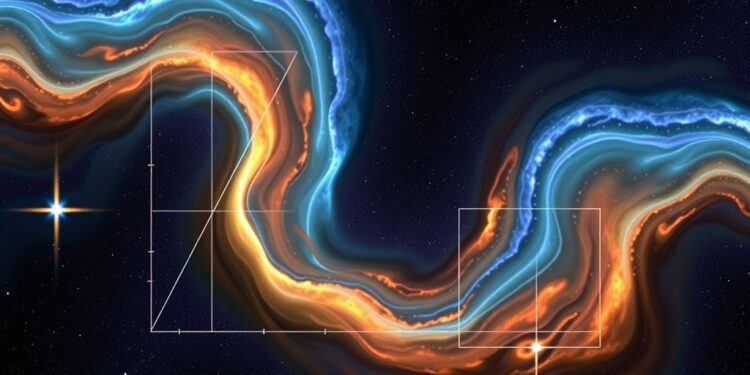RIVERSIDE, Calif. — A breakthrough in astrophysical research has emerged from the University of California, Riverside, challenging long-held beliefs about dark matter in our galaxy. The GD-1 stellar stream, a fascinating cosmic structure observed in the Milky Way’s halo, has puzzled researchers due to its peculiar spur and gap features. These unusual characteristics lead scientists to turn their attention to the role of subhalos, and a recent study suggests that a self-interacting dark matter (SIDM) subhalo may hold the key to understanding these enigmatic structures.
The GD-1 stellar stream is a remarkable collection of stars that travel together along a shared path, providing astronomers with a unique window into the dynamics of galactic formation and structure. Stellar streams are crucial for studying the distribution of dark matter since the gravitational effects of dark matter influence these streams’ positions and movements in the galaxy. Researchers have long noted the distinctive spur and gap features within GD-1, but attributing these features to known objects in the Milky Way’s environment proved challenging.
Yu elaborated on the significance of this discovery, stating, “CDM subhalos typically lack the density needed to produce the distinctive features observed in the GD-1 stream.” He emphasized that the potential for a collapsing SIDM subhalo could generate sufficient density to exert the gravitational influence required to shape the stellar stream in the observed manner.
The implications of this research are profound. As dark matter makes up approximately 85% of the matter in the universe, understanding its properties is pivotal to our comprehension of cosmic evolution. The transition from traditional CDM models to SIDM opens the door to a new exploration of dark matter’s self-interacting properties, providing a pathway to unraveling the complexities of dark matter’s role in shaping our universe.
One key aspect of the research involves the computational simulations that mimic real galactic behavior in a controlled environment. By modeling the interactions within a collapsing SIDM subhalo, the researchers found it could disrupt the spatial and velocity distributions of stars within the GD-1 stream. This generated the unique spur and gap features that have previously eluded easy explanation.
In the realm of astrophysics, stellar streams are considered invaluable for tracing dark matter because they represent the remnants of disrupted globular clusters. By analyzing these streams, astronomers glean crucial insights into the gravitational environment where they reside. Consequently, any model that accurately represents the dynamics of such streams holds significant weight in the ongoing dialogue about dark matter.
The research also contributes to ongoing conversations about dark matter’s characteristics beyond its unseen nature. The study suggests that if SIDM indeed influences the structure of stellar streams like GD-1, it might lead to new methods for detecting dark matter and understanding its fundamental properties. The results could spur further investigations into self-interaction among dark matter particles, guiding future research direction.
Yu’s collaborative approach, involving Xingyu Zhang and Daneng Yang from UCR and Ethan O. Nadler from UC San Diego, illustrates a commitment to multidisciplinary exploration in tackling cosmic mysteries. With support from institutions such as the U.S. Department of Energy and the John Templeton Foundation, their pioneering work exemplifies the synergy between theoretical modeling and observational astronomy.
As research in this area progresses, astronomers will likely revisit existing models and theories surrounding the nature of dark matter in light of new findings. Continued simulations and observational data will be imperative in testing the validity of the proposed SIDM subhalo model and its ability to consistently explain the myriad of phenomena observed in the dynamics of the GD-1 stellar stream.
The publication of this research in The Astrophysical Journal Letters signifies an important milestone, inspiring academic inquiry and public fascination with the mysteries of the universe. The potential for a paradigm shift in our understanding of dark matter dynamics could reshape how we view different cosmic structures within our own galaxy and beyond.
In conclusion, the concept of a core-collapsing self-interacting dark matter subhalo presents a compelling narrative in the quest for answers about the GD-1 stellar stream. As we delve deeper into such cosmic enigmas, the importance of collaborative efforts and innovative modeling techniques will remain at the forefront of astronomical research, driving us to newer horizons in our quest for knowledge about the universe’s unseen components.
Subject of Research: Dark matter and its effects on the GD-1 stellar stream.
Article Title: The GD-1 Stellar Stream Perturber as a Core-collapsed Self-interacting Dark Matter Halo.
News Publication Date: January 3, 2025.
Web References: The Astrophysical Journal Letters
References: Not applicable.
Image Credits: Not applicable.
Keywords
Dark matter, GD-1 stellar stream, self-interacting dark matter, astrophysics, galactic dynamics, N-body simulations.





